Edinburgh came into being beneath Castle Rock, a rocky crag overlooking the coastal route to central Scotland from northeast England. A fortification existed there since at least the 7th century, and a royal castle since the reign of King David I in the 12th century. Today Edinburgh Castle is one of Scotland’s most popular tourist destinations, and is the backdrop for the famous Edinburgh Military Tattoo. From Greenock we made a two-night trip to Edinburgh and had an excellent time touring the historic city and taking in the Tattoo.
Trip highlights from August 8th and 9th, 2017 follow. Click any image for a larger view, or click the position to view the location on a map. And a live map of our current route and most recent log entries always is available at http://mvdirona.com/maps
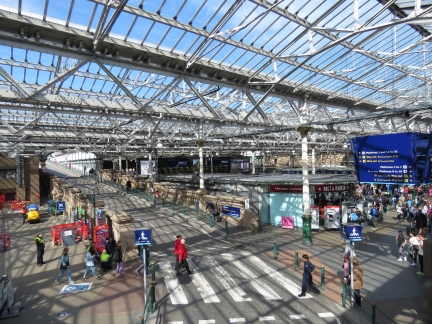 |
Waverley Station
Position: -3 11.35, 55 57.11
At Waverley Station in Edinburgh. The entire trip from Greenock to Edinburgh took only 2 and a bit hours by train, including a station change in Glasgow.
|
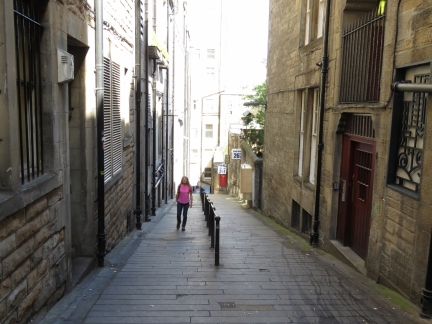 |
Carrubber’s Close
Position: -3 11.22, 55 57.03
Walking up Carrubber’s Close in the original Old Town district of Edinburgh. Old Town is full of narrow, steep closes (Scottish for alley) running between multi-storey buildings.
|
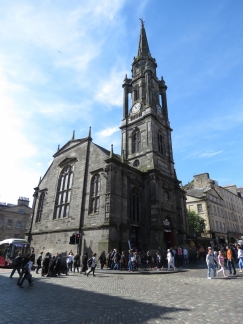 |
Tron Kirk
Position: -3 11.25, 55 57.01
Tron Kirk was dedicated in 1641 and operated as a church for 300 years. After standing empty for nearly 50 years, a small market now operates inside.
|
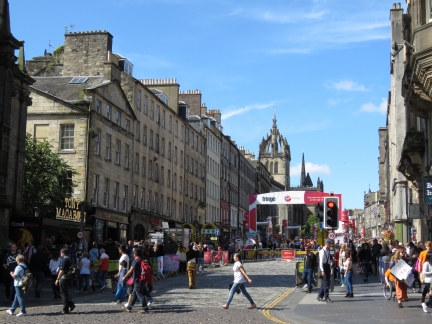 |
Fringe Festival
Position: -3 11.25, 55 57.01
August is festival season in Edinburgh and the streets are packed. The sign up the street is for the Edinburgh Fringe Festival, started in 1947 and currently the world’s largest arts festival. In 2016, the festival featured 50,266 performances of 3,269 shows in 294 venues over 26 days in August.
|
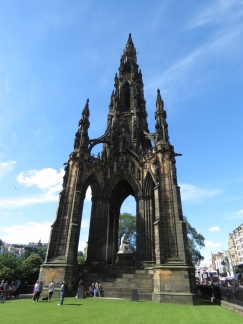 |
Scott Monument
Position: -3 11.52, 55 57.17
The 200ft Scott Monument in the New Town district was completed in 1844 and is the largest monument in the world dedicated to Scottish author Sir Walter Scott. 297 stairs lead to the top for fabulous views of Old Town and New Town.
|
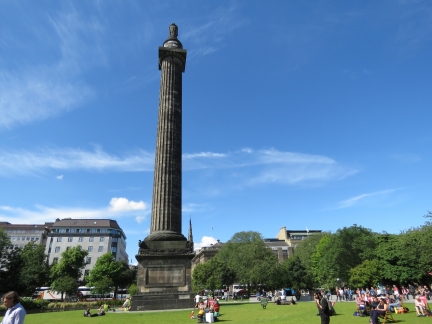 |
St. Andrew Square
Position: -3 11.56, 55 57.29
St. Andrew Square was built in the late 1700s as part of the New Town development of Edinburgh. The Melville Monument was constructed in 1823 to honor Henry Dundas, the first Viscount of Melville. Dundas was a key player in the Scottish Enlightenment, a period of great intellectual and scientic achievement in Scotland during the the 18th and early 19th centuries.
|
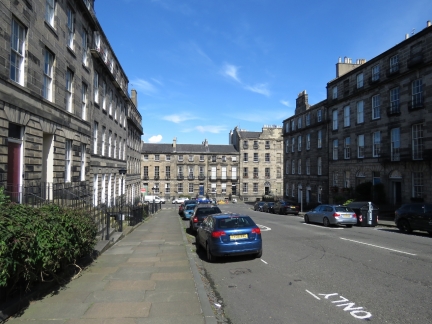 |
New Town
Position: -3 11.79, 55 57.43
The planned development of New Town was created in the late 1700s across a valley from the original Old Town. The district is among the finest examples of Georgian architecture and town planning in the world.
|
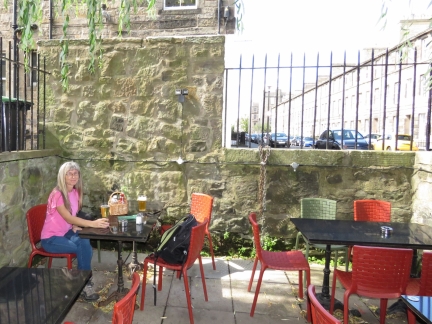 |
The Cumberland
Position: -3 11.84, 55 57.54
A delicious lunch on the patio at the Cumberland Bar in New Town.
|
 |
Dundas House
Position: -3 11.51, 55 57.24
Originally built as a mansion for Sir Lawrence Dundas in 1772-1774, the impressive Dundas House on St. Andrew Square has been the head office of the Bank of Scotland since 1825. The building facade is featured on the current issue of their bank notes. In most countries we’ve visited, bank notes are issued by a single central authority. But in the United Kingdom, multiple banks can issue notes that don’t have UK-wide acceptance. Bank of Ireland notes issued in Northern Ireland, for example, are not legal tender in England, although some vendors might accept them. And several venues in Scotland would not accept Isle of Man notes. We’ve since learned that the Ilse of Man is not actually a part of the UK at all, but is a self-governing crown dependency.
|
 |
Hub
Position: -3 10.99, 55 57.09
Jennifer using the self-checkin for our room at The Hub in Old Town Edinburgh. The Hub is a modern but no-frills hotel that worked out very well for our stay.
|
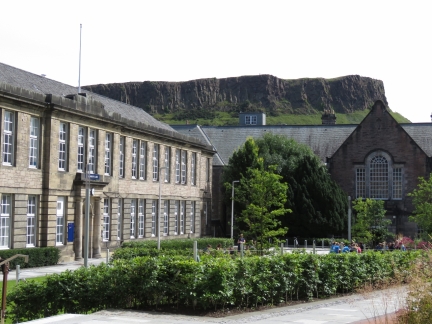 |
Thomson’s Land
Position: -3 10.84, 55 57.08
The University of Edinburgh’s Thomson’s Land estate with the Salisbury Crags in the background.
|
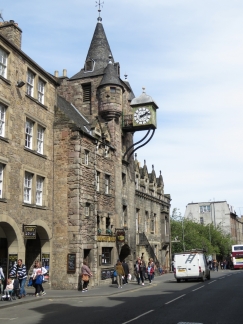 |
Canongate Tolbooth
Position: -3 10.80, 55 57.08
The tower of Canongate Tolbooth (‘tolbooth’ means center of administration) was built in 1591. The clock shown was added in 1884, suspended over the street on wrought iron brackets.
|
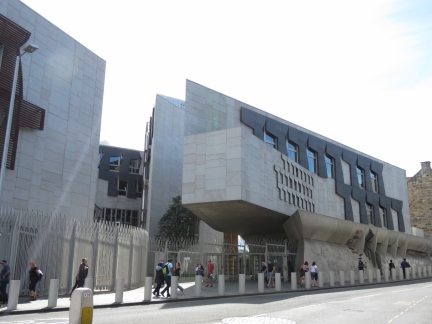 |
New Parliament
Position: -3 10.47, 55 57.16
Following a 1997 Scottish vote in favor of a devolved Parliament, the Scottish Parliament met in 1999 for the first time in 300 years. Their controversial new Parliament Building at the east end of Old Town is an eclectic collection of concrete and wood in seemingly random placement that is at odds with surrounding architecture. But from our perspective, it seems to work.
|
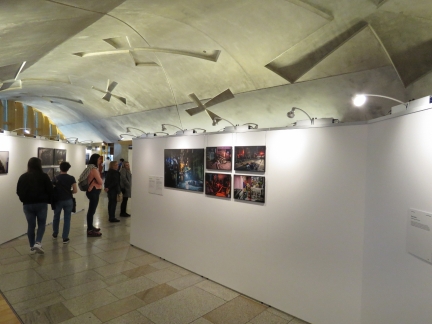 |
World Press Photo Exhibit
Position: -3 10.48, 55 57.13
The striking Debating Center in the Scottish Parliament building was unfortunately closed for maintenance, but we did spend some time viewing the often-sobering images in the World Press Photo Exhibit inside the Main Hall.
|
 |
Firth of Forth
Position: -3 9.72, 55 56.64
View to the Firth of Forth, connecting Edinburgh to the North Sea, from the top of 823ft (251m) Arthur’s Seat in Holyrood Park.
|
 |
Saint Anthony’s Chapel
Position: -3 9.72, 55 56.64
The ruins of Saint Anthony’s Chapel viewed from Arthur’s Seat. The chapel is thought to be built in the 1300s, but little is know about its history.
|
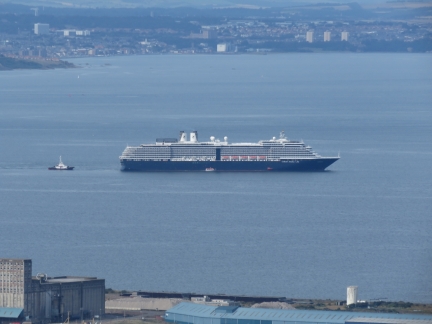 |
Cruise Ship
Position: -3 9.73, 55 56.64
Cruise ship anchored in the Firth of Forth of Edinburgh.
|
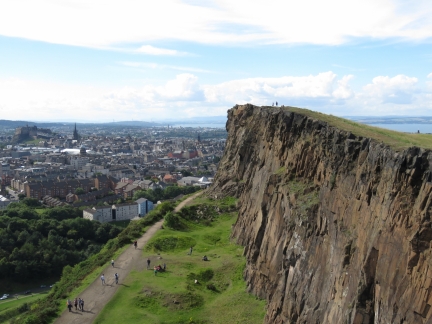 |
Salisbury Crags
Position: -3 10.31, 55 56.70
Looking north across Salisbury Crags at Holyrood Park with Edinburgh Castle in the distance at the far left.
|
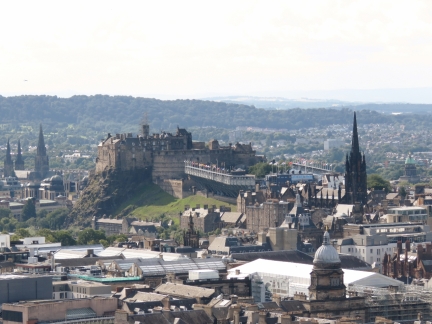 |
Edinburgh Castle
Position: -3 10.45, 55 56.75
View to Edinburgh Castle from the Salisbury Crags. The stadium directly to the left of the castle is where the acclaimed Edinburgh Military Tattoo performs. We have tickets for tomorrow night.
|
 |
View
Position: -3 10.46, 55 56.79
The panoramic view from the Salisbury Crags with Edinburgh Castle roughly at enter and the Firth of Forth on the right. Old Town extends right from the castle and New Town is in the distance to the left of the treed area at the right of the picture.
|
 |
Palace of Holyroodhouse
Position: -3 10.29, 55 56.94
The Palace of Holyroodhouse, at left, the Royal Family’s official residence in Scotland. Mary, Queen of Scots, lived here in the 16th century. In the foreground is an exhibit of 70 Ferraris, celebrating the company’s 70th anniversary.
|
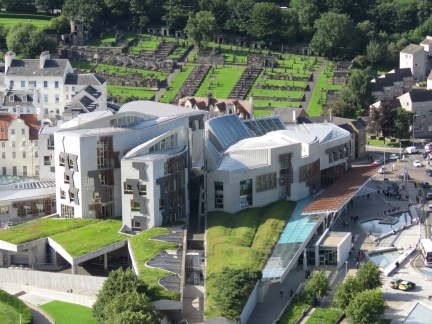 |
Parliament from Above
Position: -3 10.29, 55 56.94
A view to the modern Scottish Parliament buildings from above.
|
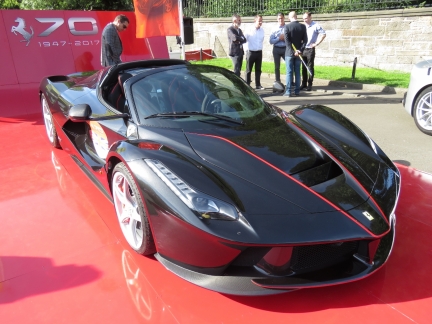 |
LaFerrari Aperta
Position: -3 10.30, 55 57.06
We checked out the Ferarri Exhibit after hiking through Holyrood Park. The cars mostly were modern and spectacular, particularly this LaFerrari Aperta, Ferrari’s latest limited-edition special series model built for the 70th anniversary. The car uses hybrid technology coupling a 788HP V12 with a 160 HP electric motor for a total output of over 946 HP with a maximum speed of over 217mph (350km/h).
|
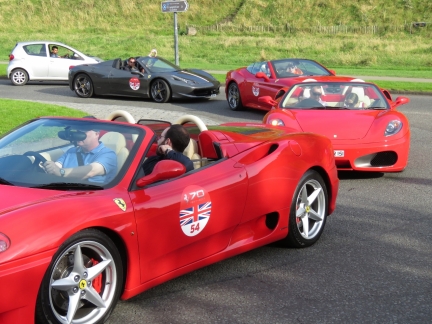 |
Ferrari Parade
Position: -3 10.33, 55 57.04
At 6pm, the Ferrari Exhibit set off on a parade through town, with plenty of engine revving. The followed roughly the route we were walking to dinner and the streets were so busy that we mostly outpaced the cars. It’s not often that we outrun Ferraris.
|
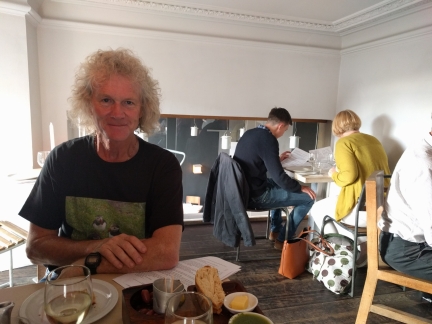 |
The Outsider
Position: -3 11.51, 55 56.88
An excellent meal at the Outsider Restaurant in Old Town. Happy Birthday James!
|
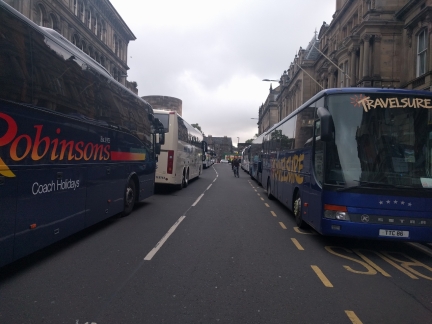 |
Tour Buses
Position: -3 11.38, 55 56.85
Tour buses, all labelled ‘Tattoo’ lined the streets as we walked back after dinner.
|
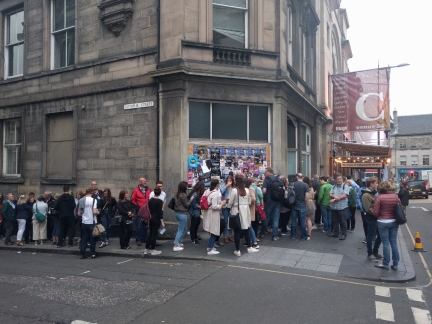 |
Queue
Position: -3 11.26, 55 56.87
A queue for a Fringe Festival event. The steets were still quite busy in the early evening.
|
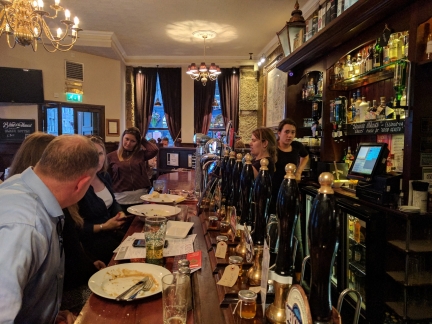 |
The World’s End
Position: -3 11.06, 55 57.04
A drink at the World’s End Pub to finish the evening. In the 16th century, Edinburgh was a walled city and the people of Edinburgh felt the world outside the city was no longer theirs. The pub sits where the old city gates were, hence the name.
|
 |
Queue
Position: -3 11.48, 55 57.05
We stopped in at the ticket office this morning to pickup tonight’s Edinburgh Tattoo tickets that we’d ordered back in February while in Daytona Beach, Florida. The Edinburgh Tattoo is incredibly popular and ticket-buyers already were lined up before the office opened. Over 200,000 people see the Tattoo live each year, and it has sold out in advance for the past decade. Fortunately we didn’t have to stand in that queue to pickup our tickets.
|
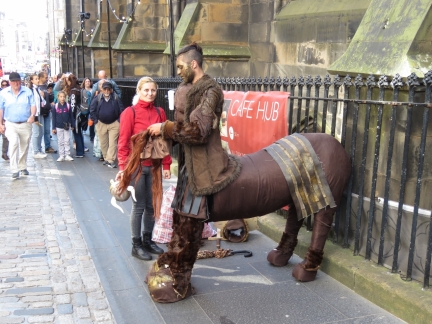 |
Street Performer
Position: -3 11.78, 55 56.93
Street performer outside Edinburgh Castle, getting ready for his day.
|
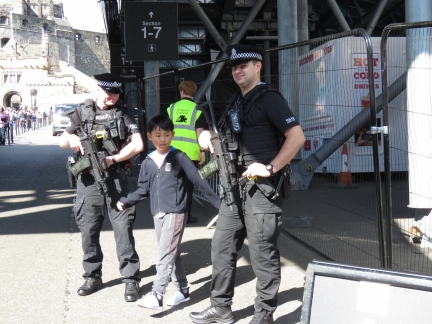 |
Police
Position: -3 11.80, 55 56.93
These well-armed, but friendly, military police officers just posed for a photograph outside Edinburgh Castle.
|
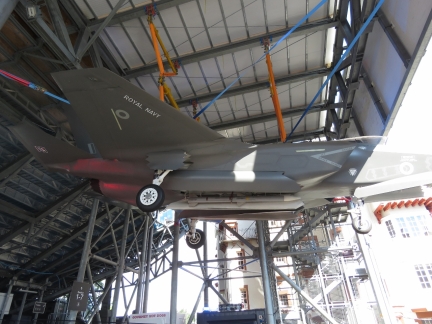 |
Jet
Position: -3 11.81, 55 56.93
Full scale model of a Royal Navy Lockheed Martin F35 Lightning II jet fighter strung above the entrance to Edinburgh Castle.
|
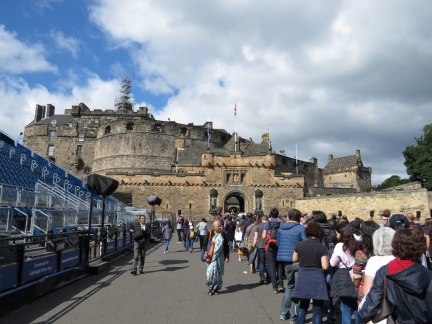 |
Edinburgh Castle
Position: -3 11.86, 55 56.91
Edinburgh Castle is among Scotland’s most popular tourist destinations. We’d pre-purchased our tickets, but still had to stand in this long queue to enter. A royal castle has been here since at least the 12th century, and the castle was a royal residence until the 17th century when it was re-purposed as military barracks.
|
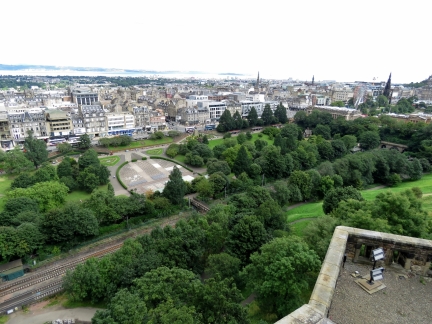 |
New Town
Position: -3 12.03, 55 56.95
Perched high on Castle Rock, Edinburgh Castle has excellent views to the surrounding area. This is looking southwest across the New Town district from the battlements.
|
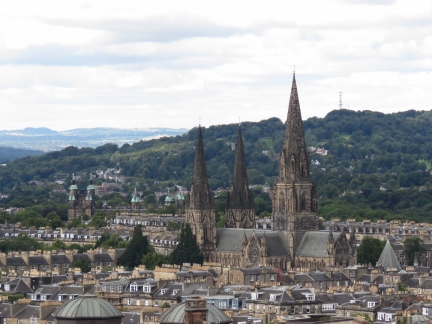 |
St. Mary’s Cathedral
Position: -3 12.12, 55 56.93
St. Mary’s Episcopal Cathedral, built in New Town in the late 19th century, viewed from Edinburgh Castle.
|
 |
St. Cuthbert’s
Position: -3 12.08, 55 56.93
St. Cuthbert’s chapel in West Princes Street Gardens, viewed from Edinburgh Castle. The chapel was dedicated in 1894, but a chapel to St. Cuthbert stood on this site in 850, making the current chapel the oldest building in Edinburgh by foundation.
|
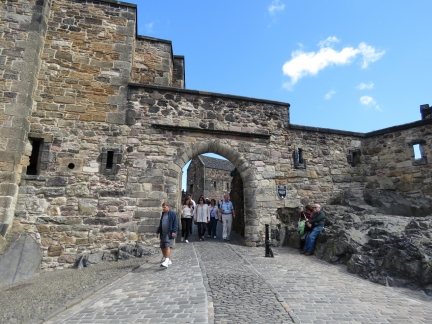 |
Foog’s Gate
Position: -3 12.01, 55 56.91
Passing through Foog’s Gate, the original castle gate into the upper ward.
|
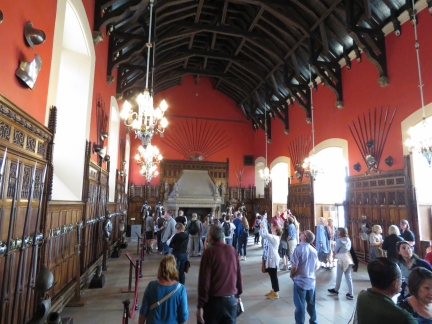 |
Great Hall
Position: -3 12.00, 55 56.89
The Great Hall in Edinburgh Castle was built before the death of King James IV in 1513 and served as the main hall for state assembly in the castle. Arms and coats of armor ring the room.
|
 |
Honours of Scotland
Position: -3 11.97, 55 56.91
The Honours of Scotland (Scottish Crown Jewels) are on display at the castle, but seeing them required standing in a long queue, so we passed.
|
 |
Esplanade
Position: -3 11.99, 55 56.92
Looking down a cannon across the Castle Esplanade to the Edinburgh Tattoo grandstand.
|
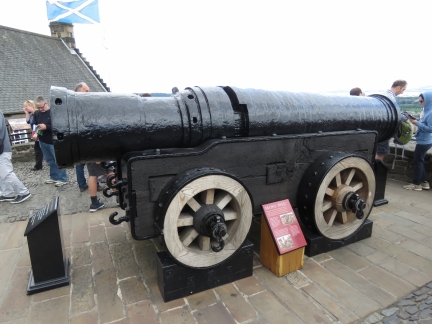 |
Mons Meg
Position: -3 12.01, 55 56.93
Mons Meg, a massive siege gun, was built in 1449 at Mons (in what is now Belgium). Mons Meg is one of the largest cannons in the world, with a 20-inch (510mm) calibre (barrel diameter).
|
 |
Dog Cemetery
Position: -3 12.01, 55 56.91
This cemetery for soldiers’ dogs at Edinburgh Castle is one of only two in Scotland for the companions of the castle’s commanding officers.
|
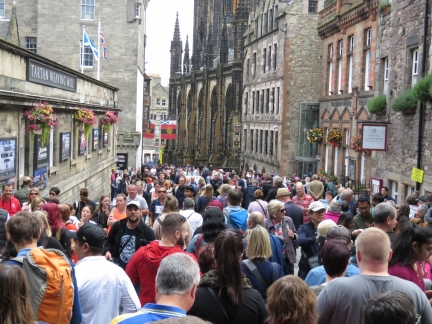 |
Crowds
Position: -3 11.75, 55 56.93
The streets were quite literally packed as we left Edinburgh Castle around noon.
|
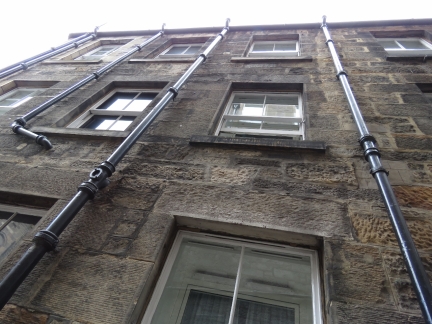 |
Plumbing
Position: -3 11.46, 55 57.05
All the buildings in the area have plumbing pipes running down the outside. The buildings were constructed before indoor plumbing and so it was retrofitted later on the outside walls.
|
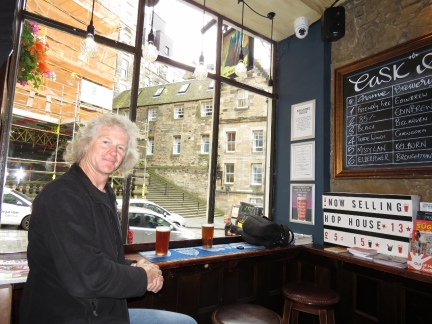 |
Malt Shovel
Position: -3 11.45, 55 57.04
Excellent burgers with a street-side view at the Malt Shovel Inn.
|
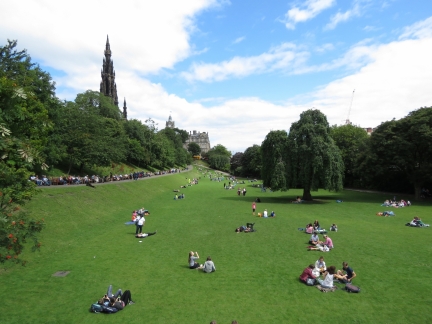 |
Princes Street Gardens
Position: -3 11.72, 55 57.10
After lunch we walked north across Princes Street Gardens to New Town. The gardens were created from a drained bog in the early 19th century.
|
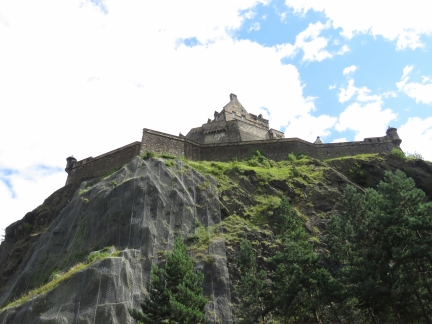 |
Castle Rock
Position: -3 12.19, 55 56.97
Looking up to Edinburgh Castle, perched on Castle Rock, from Princes Street Gardens.
|
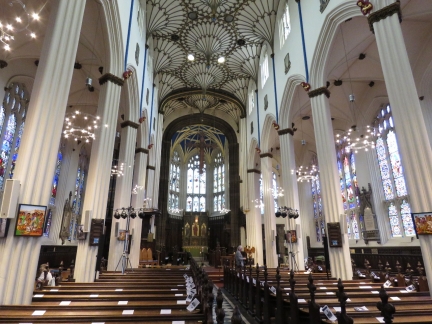 |
St. John’s Episcopal Church
Position: -3 12.41, 55 57.01
The soaring and beautiful interior of St. John’s Episcopal Church, dedicated in 1818, at Princes Street and Lothian Road.
|
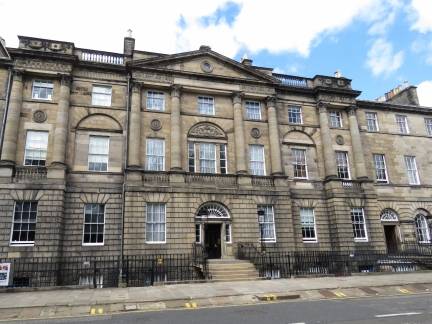 |
Bute House
Position: -3 12.48, 55 57.14
Charlotte Square, at the west end of New Town, has some of the finest examples of Georgian architecture in the world. Bute House, Number 6 along the north side, is the official residence of Scotland’s first minister, the equivalent of 10 Downing Street in London.
|
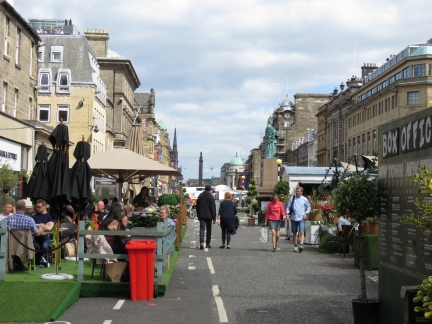 |
George Street
Position: -3 12.24, 55 57.15
Much of George Street was closed for the festival season, and many of the restaurants had set up popular temporary patios along the street.
|
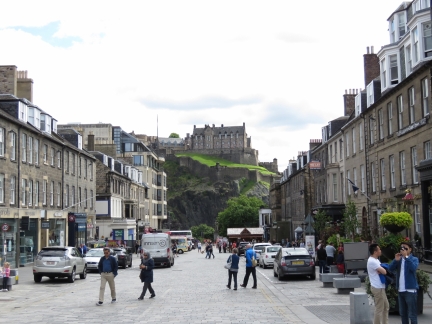 |
Castle Street
Position: -3 12.20, 55 57.15
Looking south along Castle Street to Edinburgh Castle, which dominates the city skyline.
|
 |
Calton Hill
Position: -3 11.05, 55 57.29
We continue walking west through New Town to take the best views in the city from Calton Hill. This is looking back across New Town from Old Observatory House with Edinburgh Castle in the distance on the left. At the near left is a monument to Dugald Steward, an 18th-century philosopher and mathematician whose lectures at the University of Edinburgh popularized the Scottish Enlightenment. The buildings on the right contain some of Edinburgh’s many rooftop gardens, complete with grass.
|
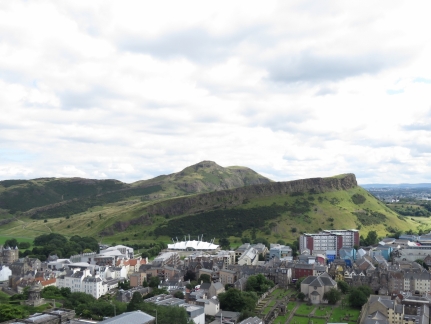 |
Arthur’s Seat
Position: -3 10.95, 55 57.26
Arthur’s Seat, that we climbed yesterday, viewed from Calton Hill. The Palace of Holyrood House is at the far left and the new Scottish Parliament is just to its the right.
|
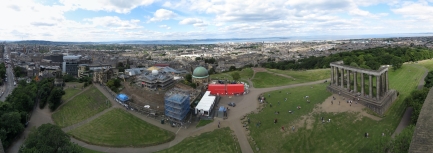 |
Nelson Monument
Position: -3 10.95, 55 57.26
View north across the Calton Hill from the top of the Nelson Monument with the Firth of Forth in the distance. The Nelson Monument was built to commemorate Admiral Lord Nelson’s victory at Trafalgar in 1805. On the left is the City Observatory, built in 1818 following the design of the ancient Greek Temple of the Winds in Athens. At right is the National Monument, an early 1800s attempt to replicate the Parthenon in Athens to honor Scots who died in the Napoleonic Wars. Funding ran out after only 12 columns were completed.
|
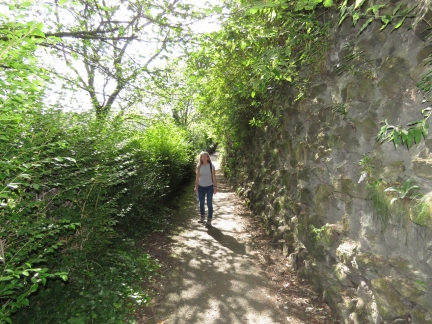 |
Path
Position: -3 10.78, 55 57.19
A nice wooded path, that appeared to be an old road, led down the steep bank from Regent Rd to Calton Rd.
|
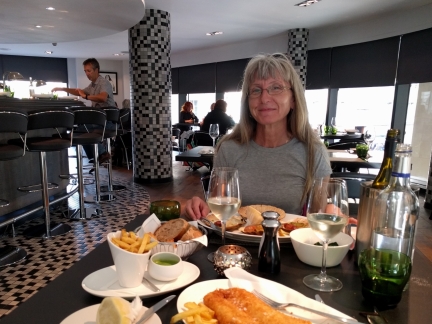 |
Ondine
Position: -3 11.55, 55 56.94
We had an excellent seafood meal at Ondine before the tattoo.
|
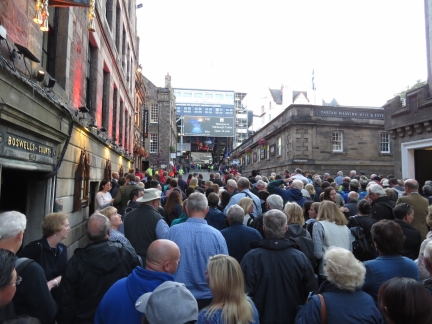 |
Tattoo Crowds
Position: -3 11.76, 55 56.93
Castlehill street below the castle was packed with Tattoo attendees. Plenty of security personnel were on hand, but they seemed mainly for crowd control. Bag inspections and other security checks weren’t nearly as strict as what we’ve experienced in the US at events such as football games.
|
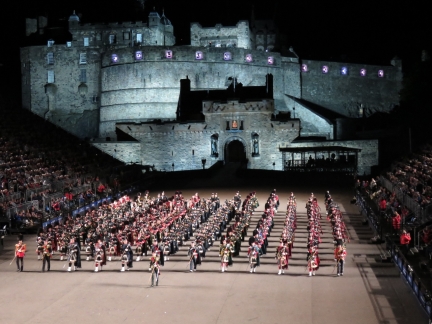 |
Edinburgh Tattoo
Position: -3 11.81, 55 56.93
A tattoo is marching, exercises and other entertainment displays performed by military personnel to music, such as a marching band. This is generally not our preferred form of entertainment, but we had a fabulous time at the Edinburgh Tattoo and really enjoyed the show. Troupes from around the world put on an excellent performances and the castle made a dramatic backdrop to the disolays. And because we’d bought our tickets back in February, we had excellent seats.
|
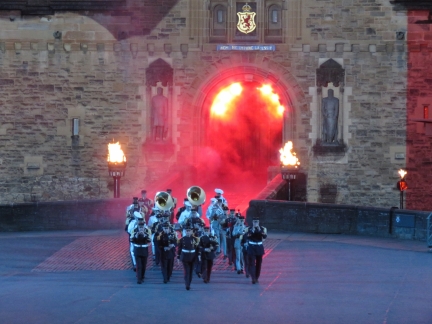 |
France
Position: -3 11.81, 55 56.93
The Fanfare Band of the 9th French Marine Infantry Brigade takes the stage through the castle gates amid a fiery light display.
|
 |
Fireworks
Position: -3 11.81, 55 56.93
A dramatic fireworks display near the end of the Tattoo with Edinburgh Castle aglow in the background. When we started attending music concerts, people held up lit cigarette lighters to show approval and request an encore. Now they hold up cell phones.
|

|
Click the travel log icon on the left to see these locations on a map, with the complete log of our cruise.
On the map page, clicking on a camera or text icon will display a picture and/or log entry for that location, and clicking on the smaller icons along the route will display latitude, longitude and other navigation data for that location. And a live map of our current route and most recent log entries always is available at http://mvdirona.com/maps. |

If your comment doesn't show up right away, send us email and we'll dredge it out of the spam filter.